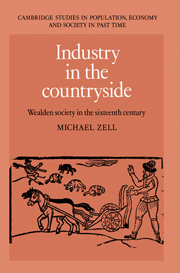Book contents
- Frontmatter
- Contents
- List of figures
- List of tables
- Acknowledgements
- List of abbreviation
- 1 Introduction
- 2 Landholding, inheritance and the local land market
- 3 Demographic movements, household structure and geographical mobility
- 4 The Wealden agrarian regime
- 5 Occupational structure and levels of wealth in the Weald
- 6 The textile industry in the Weald
- 7 Clothiers and capitalism
- 8 The Weald and ‘proto-industrialization’
- Bibliography
- Index
- Cambridge Studies in Population, Economy and Society in Past Time
5 - Occupational structure and levels of wealth in the Weald
Published online by Cambridge University Press: 13 October 2009
- Frontmatter
- Contents
- List of figures
- List of tables
- Acknowledgements
- List of abbreviation
- 1 Introduction
- 2 Landholding, inheritance and the local land market
- 3 Demographic movements, household structure and geographical mobility
- 4 The Wealden agrarian regime
- 5 Occupational structure and levels of wealth in the Weald
- 6 The textile industry in the Weald
- 7 Clothiers and capitalism
- 8 The Weald and ‘proto-industrialization’
- Bibliography
- Index
- Cambridge Studies in Population, Economy and Society in Past Time
Summary
The crucial role of agriculture in the Wealden economy – and in the family economy of its inhabitants – has been emphasized in chapter 4. But the same could be argued for any region of England and Wales in the sixteenth and seventeenth centuries. The contention of this, and succeeding chapters, is that the Weald was an agricultural region with a difference: its farming regime co-existed with – and complemented – an extremely diverse non-agricultural economy. The burden of the present chapter is two-fold: first, to describe and analyse the occupational structure of the Kent Weald, and secondly, to examine the levels of wealth within different occupational groups as well as in different parts of the Weald. The region's key non-agricultural industry, clothmaking, will only be treated cursorily here, and is the subject of more detailed examination in chapters 6 and 7. Two other branches of manufacturing – ironmaking and the associated metalware trades, and the leather industry – were in the sixteenth century concentrated in a limited number of rural areas. The Weald was one such region. Neither was as important to the people of the Kent Weald as textiles, but both will be discussed in this chapter.
The occupational structure of rural areas in early modern England is comparatively poorly documented, in contrast with what can be discovered about urban occupations. Certainly there is anecdotal evidence aplenty of men and women practising a variety of trades in many rural parishes.
- Type
- Chapter
- Information
- Industry in the CountrysideWealden Society in the Sixteenth Century, pp. 113 - 152Publisher: Cambridge University PressPrint publication year: 1994



